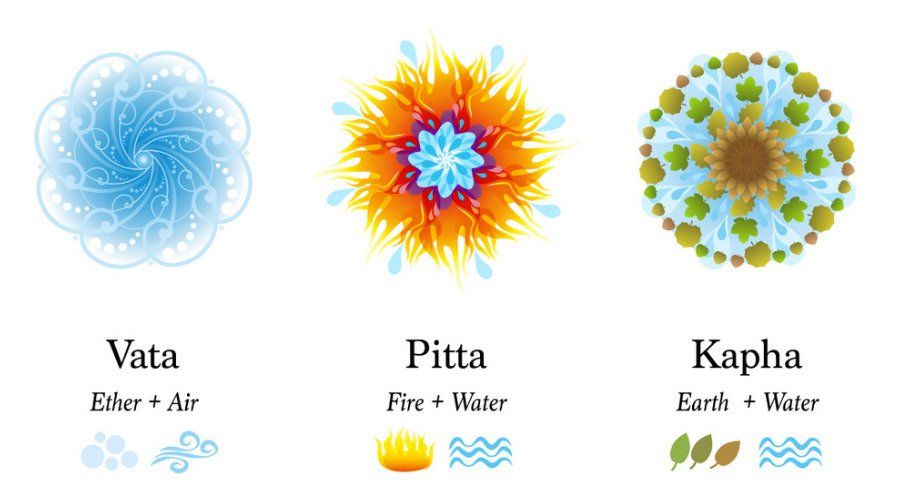According to the Ayurvedic perspective, the human body has a Prakriti (nature) of its own and it is formed with the combination of five elements present in the universe. The universe contains five elements; Space, Air, Water, Fire, and Earth. These elements combine to form the energies called Doshas. Three Doshas exist in the human bodies which are collectively called Tridoshas. The dominance of Dosha occurs at the time of conception. The composition of Doshas is accordingly:

- Vata Dosha - Air + Space
- Pitta Dosha -Fire + Water
- Kapha Dosha - Earth + Water
Let’s know more about these Doshas and their properties in detail.
VATA DOSHA
It comprises of Air and Space, and the name of the Dosha means to move like a wind. Vata Dosha controls all the movements which happen in the body and the mind. Breathing, blood flow, waste elimination, and thoughts in the brain are managed by this Dosha.
Qualities of Vata:
- Dryness
- Light
- Coldness
- Roughness
- Movement
Location:
Majorly it is found in the lower portion of the body covering the abdominal and pelvic region. The main place where the Vata resides is the colon. The presence of Vata Dosha can also be seen in the ears, bones, hips, thighs, and organs of touch (skin).
There are five subtypes of Vata Dosha which are discussed below.
- Prana Vayu: It is present in the head region. It is responsible for giving commands for intellectual abilities, the brain, and sense organs. It also causes sneezing, respiratory movements, burping, and swallowing.
- Udana Vayu: It is located in the chest. The major functions exhibited are the production of speech, energy, memory, color, strength, and endurance.
- Samana Vayu: Its location is the stomach and intestinal region. Its main function is to digest and assimilate the food.
- Vyana Vayu: It presents itself in the entire body. It distributes various important things in the body.
- ApanaVayu: It is located below the navel. It performs the functions like the elimination of urine, fecal matter, and menstrual blood. Additionally, it also helps in fetus delivery.
What happens when there is an imbalance in Vata Dosha? Let us read more about it.
Vata Dosha can be increased as well as decreased depending upon the conditions. Both situations have different sets of symptoms.
When there is an increase in Vata Dosha a person may experience prickling sensation in the abdomen, constipation, flatulence, fatigue, loss of immunity, tremors, insomnia, urinary disorders, diabetes, piles, joint pain, knee pain and back pain.
But if there is a decrease in the Dosha, people may have a loss of speech, lack of enthusiasm towards the activities, loss of consciousness, shortness of breath, and cough.
How to balance the Vata Dosha?
Now we will find how with an Ayurvedic approach we can balance the Dosha. With the involvement of Ayurvedic herbs, spices, changes in diet and lifestyle one can maintain the balance and hence protect one from diseases and disorders.
- Consumption of foods those are warm, moist, and cooked properly.
- Preference of sweet, sour, and salty taste food articles.
- Having a routine of meals, exercise, sleeping, and meditation.
- Have sweet potatoes, grains, soups, honey, and cow’s ghee to pacify the Dosha.
- Spices such as cinnamon, cumin, salt, pepper, cardamom will keep the levels of Vata Dosha in an appropriate amount.
- Herbs like Ginger, basil with their natural properties will keep the Vata Dosha in balance.
- Adding fresh fruits and vegetables such as avocados, bananas, sweet and sour veggies.
- Don’t eat dry, raw, and undercooked foods.
- Massaging the body with herbal oils, especially the feet is going to help fabulously.
- Meditate on a daily basis to keep negative thoughts away.
- Cow’s ghee gives miraculous results in balancing Vata Dosha.
PITTA DOSHA
Pitta is dominated by the fire element. Every cell requires heat for proper functioning so this Dosha is responsible for heat production and regulation in the body. The heat helps in the digestion of food and helps in the conversion of food into nutrition.
Qualities of Pitta:
- Hot
- Light
- Intense
- Flowing
Location:
It is chiefly located between the heart and navel which is the middle region of the body. It is located in the stomach, duodenum, intestines, and pancreas. It is also present in sweat, plasma, blood, eyes, and skin.
The Pitta Dosha has 5 Subtypes:
- Pachaka Pitta: It is located in the stomach, duodenum, and intestines. It helps in the digestion of food, and conversion of food particles into nutrition and waste products.
- Sadhaka Pitta: It is located in the brain and heart region. It is responsible for intellectual abilities and helps in the discrimination of various feelings.
- Ranjaka Pitta: It is present in the liver, spleen, and stomach region. It provides the color to the blood and the juices present in the body.
- Alochaka Pitta: It is located in the eyes. It works for the vision and promotes eyesight.
- Bhrajaka Pitta: It is present in the skin region. It gives pigment to the skin.
Now, what if Pitta Dosha is unbalanced? What changes do occur in the body?
When Pitta is decreased in the body of the person, the person might have issues in their digestive system. Indigestion and a decrease in body temperature are major symptoms.
On the other hand, when Pitta is increased in the body, there occurs discoloration of skin, urine, stool, and eyes into the yellow shade, heart burn, excessive hunger, thirst, and sweating.
How can Pitta Dosha be balanced?
- Consumption of milk, Cow’s ghee.
- Avoid hot, spicy, fermented food items.
- Include green vegetables, fresh fruits like apples, bananas, watermelon.
- Add the salad to your diet with cucumbers, mint, and coriander.
- Spices that have a cooling effect on the body like fennel, coriander and cardamom should be regularly consumed.
- Drinking plenty of water along with juices and coconut water.
- Try to consume bitter foods.
- Avoid foods that provide heat to the body like acidic foods rather consume nourishing and refreshing foods.
- Ensure a self-care routine.
- Breathing exercises will calm the Pitta. Shitali Pranayama is known to calm the body and mind. Practice it on daily basis.
- Massage the body with coconut and lavender oils.
- Practice Yoga asanas and meditation which will calm the soul, mind, and body.
- Ash gourd juice has wonderful benefits for the disturbed Pitta Dosha.
KAPHA DOSHA
This Dosha is the binding source of the body and it provides strength and immunity to the body. As it is the natural cooling system present in the body the energy is cold and moist.
Qualities of Kapha:
- Cold
- Wet
- Heavy
- Sticky
- Soft
- Solid
- Smooth
- Steady
Location:
It is primarily located in the upper portion of the body with the main sites head and chest region. The various other regions where Kapha is present are brain, heart, and lungs. Other sites include the throat, trachea, tongue, nose, and small joints present in fingers.
Kapha Dosha also has five sub-types which are listed below:
- Avalambaka Kapha: It is present in the chest region and helps support structures of the chest.
- Tarpaka Kapha: It is located in the head region. It helps in the nourishment of the brain and sense organs.
- Bodhaka Kapha: As it is present in the tongue it helps in speech.
- Kledaka Kapha: It is located in the stomach region and is responsible for buffering the increased activity of Pitta.
- Shleshaka Kapha: Since it is present in the joints it is helpful in the lubrication of the joints.
What happens when there is an imbalance in Kapha Dosha? What symptoms occur when there is an increase and decrease in the Dosha? Get to know more about it by continuing reading this blog.
The decrease in Kapha will lead to the deficiency and the person will experience the symptoms accordingly. So when there is a decrease, body experiences dryness, looseness in joints, heaviness in the head, physical weakness, irregular heartbeat, and giddiness.
Further, if there is an increase in Kapha, the body responds differently. Heaviness in the chest, excess saliva production, shortness of breath, cough, itching, vomiting, and fatigue are the symptoms one experiences.
How to balance Kapha Dosha?
- Consume foods that are light, warm, and are cooked properly.
- Have a proper mealtime routine and do not skip meals.
- Fresh fruit should be incorporated into the diet such as apples and cranberries.
- Oily foods, foods rich in carbohydrates, processed food should be avoided.
- Light grains such as barley and rye are recommended which will pacify the Kapha Dosha.
- Honey should be added to the meals.
- Massaging the head region with herbal oils and paste will help beneficially.
- Practice walking, jogging, or low impact workout routine
- One should also practice yoga asanas and meditation as they will not only provide peace to the body but will also work wonderfully for the mind and soul.
- Grapes are wonderful for balancing Kapha Dosha
- Sunbathing is quite helpful.
To stay away from diseases and to live a healthy and fit life one must be aware of the Doshas and know how to balance them. The diet and daily activities play a vital role in the enhancement of your living. So, adopt healthy practices to keep these tridoshas in the harmony!
